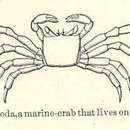en
names in breadcrumbs


Ocypode ceratophthalmus,[2] the horned ghost crab[3] or horn-eyed ghost crab,[4] is a species of ghost crab. It lives in the Indo-Pacific region (except the Red Sea); from the coast of East Africa to the Philippines and from Japan to the Great Barrier Reef. They also occur in the Pacific Islands to as far east as Polynesia and Clipperton Island.[5][6] As their common name implies, O. ceratophthalmus possess eyestalks extending beyond the eyes into long points,[7] which are longer in adults, and shorter (or even absent) in juveniles. The crabs have a box-shaped body, 6–8 centimetres (2.4–3.1 in) across the carapace, with a darker markings towards the rear in the shape of an H. The outer edges of the eye-sheaths are also sharp and broadly triangular and distinctly pointing sideways in larger individuals.[4][5] O. ceratophthalmus can run at speeds of up to 2.1 metres per second (6.9 ft/s).[8]
The characteristic "horned" eyes of O. ceratophthalmus are not unique to the species, and it should not be confused with other ghost crabs which also exhibit "horns" on the end of their eyestalks such as O. cursor, O. gaudichaudii, O. macrocera, O. mortoni, O. rotundata, and O. saratan.[5]
Purple O. ceratophthalmus on Kailua Beach, Hawaii
Green O. ceratophthalmus on Diego Garcia
Ocypode ceratophthalmus, the horned ghost crab or horn-eyed ghost crab, is a species of ghost crab. It lives in the Indo-Pacific region (except the Red Sea); from the coast of East Africa to the Philippines and from Japan to the Great Barrier Reef. They also occur in the Pacific Islands to as far east as Polynesia and Clipperton Island. As their common name implies, O. ceratophthalmus possess eyestalks extending beyond the eyes into long points, which are longer in adults, and shorter (or even absent) in juveniles. The crabs have a box-shaped body, 6–8 centimetres (2.4–3.1 in) across the carapace, with a darker markings towards the rear in the shape of an H. The outer edges of the eye-sheaths are also sharp and broadly triangular and distinctly pointing sideways in larger individuals. O. ceratophthalmus can run at speeds of up to 2.1 metres per second (6.9 ft/s).
The characteristic "horned" eyes of O. ceratophthalmus are not unique to the species, and it should not be confused with other ghost crabs which also exhibit "horns" on the end of their eyestalks such as O. cursor, O. gaudichaudii, O. macrocera, O. mortoni, O. rotundata, and O. saratan.